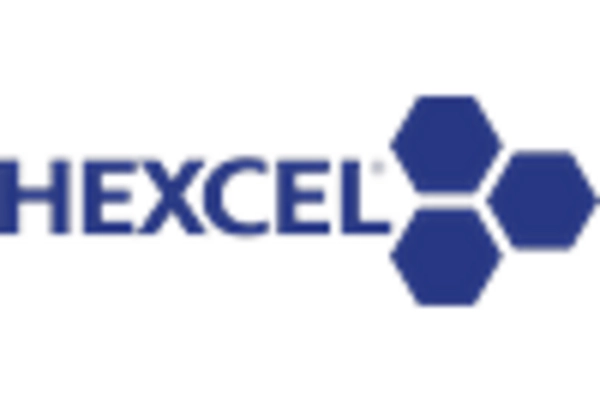Rising Demand for Lightweight Materials
The Closed Molding Composite Market is experiencing a notable increase in demand for lightweight materials across various sectors, particularly in automotive and aerospace applications. This trend is driven by the need for improved fuel efficiency and reduced emissions. For instance, composites can reduce vehicle weight by up to 30 percent compared to traditional materials, which is crucial for meeting stringent environmental regulations. As manufacturers seek to enhance performance while minimizing weight, the adoption of closed molding processes becomes more prevalent. This method not only allows for the production of complex shapes but also ensures a high-quality finish, further appealing to industries focused on innovation and sustainability. Consequently, the rising demand for lightweight materials is likely to propel growth within the Closed Molding Composite Market.
Increased Investment in Renewable Energy
The Closed Molding Composite Market is poised to benefit from the escalating investments in renewable energy sources, particularly wind energy. Wind turbine blades, which are often manufactured using composite materials, require advanced molding techniques to achieve the necessary strength and durability. The Closed Molding Composite is projected to grow significantly, with an estimated increase in installed capacity. This growth is likely to drive demand for closed molding composites, as manufacturers seek to produce larger and more efficient turbine blades. The ability of closed molding processes to create complex geometries and optimize material usage aligns well with the requirements of the renewable energy sector. As such, the intersection of renewable energy initiatives and composite manufacturing is expected to foster substantial opportunities within the Closed Molding Composite Market.
Regulatory Support for Composite Materials
Regulatory frameworks are increasingly favoring the use of composite materials, which is likely to benefit the Closed Molding Composite Market. Governments are implementing policies that promote the adoption of lightweight and durable materials in various applications, particularly in transportation and construction. These regulations often aim to reduce carbon footprints and enhance energy efficiency, aligning with global sustainability goals. As a result, manufacturers are encouraged to explore closed molding processes that yield high-quality composites suitable for compliance with these standards. The anticipated growth in regulatory support is expected to create a conducive environment for innovation and investment in the Closed Molding Composite Market, potentially leading to new applications and market expansion.
Growing Applications in the Automotive Sector
The automotive sector is a significant driver for the Closed Molding Composite Market, as manufacturers increasingly incorporate composite materials into vehicle design. The shift towards electric vehicles and hybrid models necessitates lightweight solutions to enhance battery efficiency and overall performance. Composites offer the advantage of reducing weight while maintaining structural integrity, making them ideal for various automotive components. The market for automotive composites is projected to expand, with estimates indicating a substantial increase in the use of closed molding techniques for producing parts such as body panels and structural components. This trend reflects a broader industry movement towards innovative materials that support sustainability and performance, thereby bolstering the Closed Molding Composite Market.
Technological Innovations in Manufacturing Processes
Technological advancements are reshaping the Closed Molding Composite Market, with innovations in manufacturing processes enhancing efficiency and product quality. Techniques such as vacuum infusion and resin transfer molding are gaining traction, allowing for better control over the material properties and reducing waste. These methods enable manufacturers to produce high-performance composites that meet the rigorous demands of various applications, including marine and automotive sectors. The integration of automation and digital technologies further streamlines production, potentially reducing lead times and costs. As industries increasingly prioritize efficiency and sustainability, the adoption of these advanced manufacturing techniques is likely to drive growth in the Closed Molding Composite Market, positioning it favorably for future developments.

















Leave a Comment